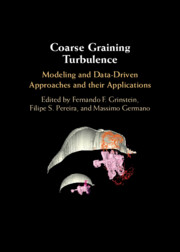Book contents
- Frontmatter
- Contents
- Contributors
- Prologue
- Part I Paradigms and Tools
- 1 Numerical Simulations and Coarse-Graining
- 2 An Overview of Scale-Resolving Simulation Models for Practical Flows
- 3 Filtering Approaches and Coarse Graining
- 4 Filtered Density Function
- 5 Symmetries, Subgrid-Scale Modeling, and Coarse Graining
- 6 Coarse-Graining Turbulence Using the Mori–Zwanzig Formalism
- 7 Data-Driven Modeling for Coarse Graining
- 8 Verification, Validation, Uncertainty Quantification, and Coarse-Graining
- Part II Challenges
- Epilogue
- Abbreviations
- Index
- References
2 - An Overview of Scale-Resolving Simulation Models for Practical Flows
from Part I - Paradigms and Tools
Published online by Cambridge University Press: 31 January 2025
- Frontmatter
- Contents
- Contributors
- Prologue
- Part I Paradigms and Tools
- 1 Numerical Simulations and Coarse-Graining
- 2 An Overview of Scale-Resolving Simulation Models for Practical Flows
- 3 Filtering Approaches and Coarse Graining
- 4 Filtered Density Function
- 5 Symmetries, Subgrid-Scale Modeling, and Coarse Graining
- 6 Coarse-Graining Turbulence Using the Mori–Zwanzig Formalism
- 7 Data-Driven Modeling for Coarse Graining
- 8 Verification, Validation, Uncertainty Quantification, and Coarse-Graining
- Part II Challenges
- Epilogue
- Abbreviations
- Index
- References
Summary
Scale-resolving simulation (SRS) methods of practical interest are coarse-graining formulations widely used in science and engineering. These methods aim to efficiently predict complex flows by only resolving the phenomena not amenable to modeling, unleashing the concept of accuracy on demand. This chapter provides an overview of the SRS methods best suited for engineering applications: hybrid and bridging models. It starts by reviewing basic turbulence modeling concepts. Following on from that is an overview of hybrid and bridging models, discussing their main advantages and limitations. The challenges to the predictive application of these models are enumerated, as well as possible strategies to solve or mitigate them. Several examples are provided to illustrate the potential of these classes of SRS methods. Overall, the chapter intends to help new and experienced SRS modelers and users obtain predictive turbulence computations.
- Type
- Chapter
- Information
- Coarse Graining TurbulenceModeling and Data-Driven Approaches and their Applications, pp. 48 - 90Publisher: Cambridge University PressPrint publication year: 2025

